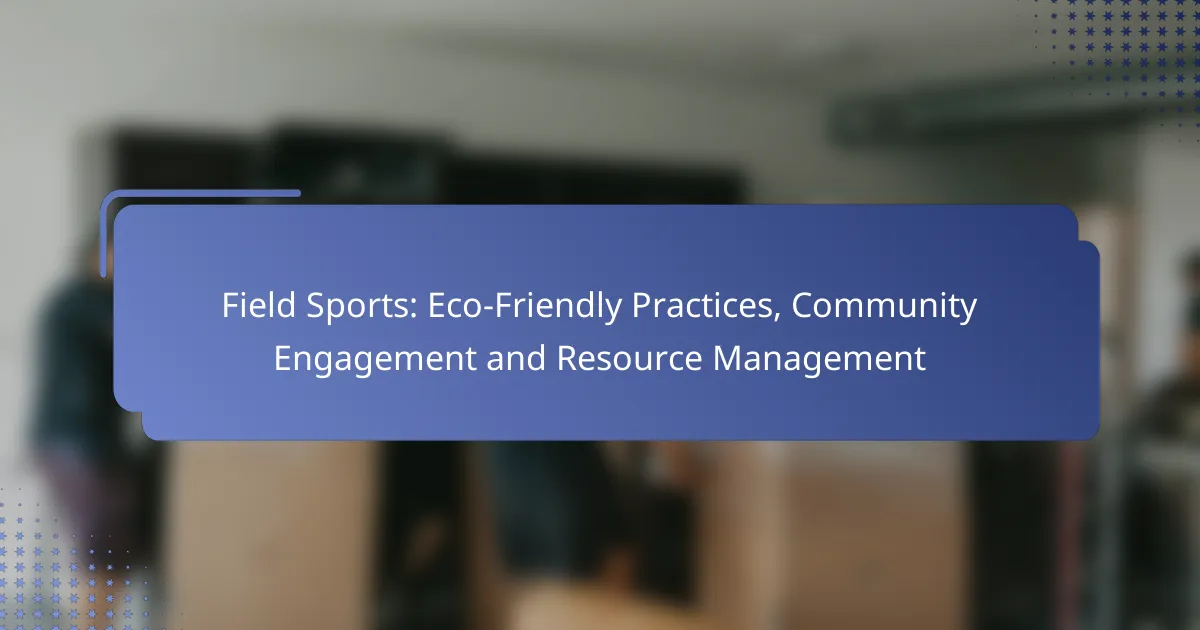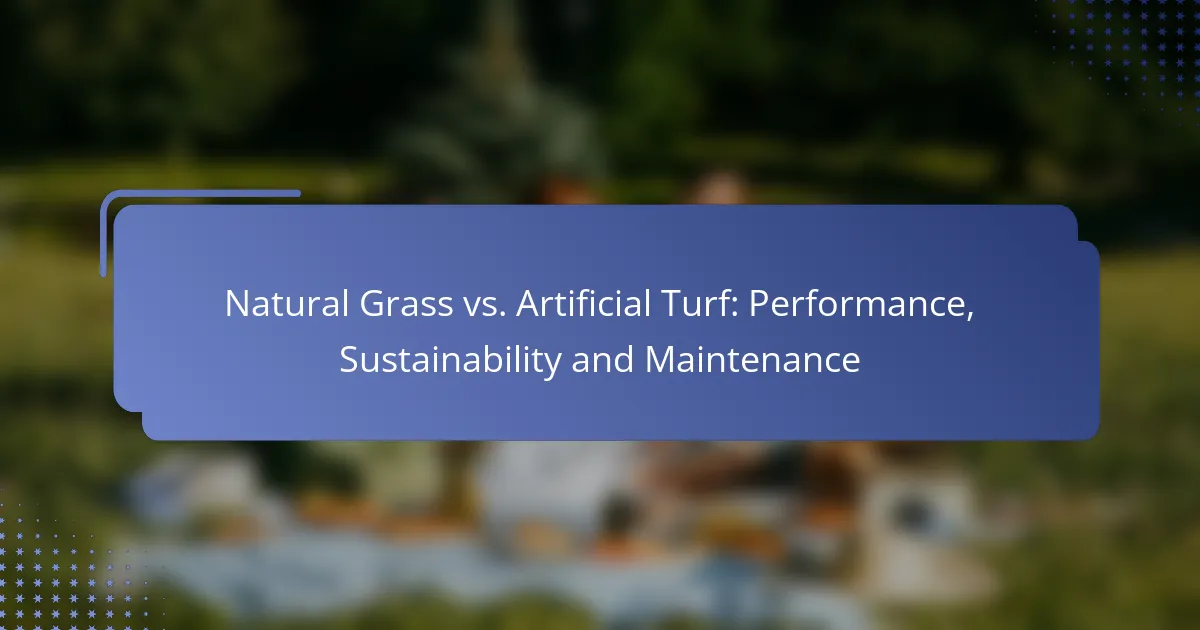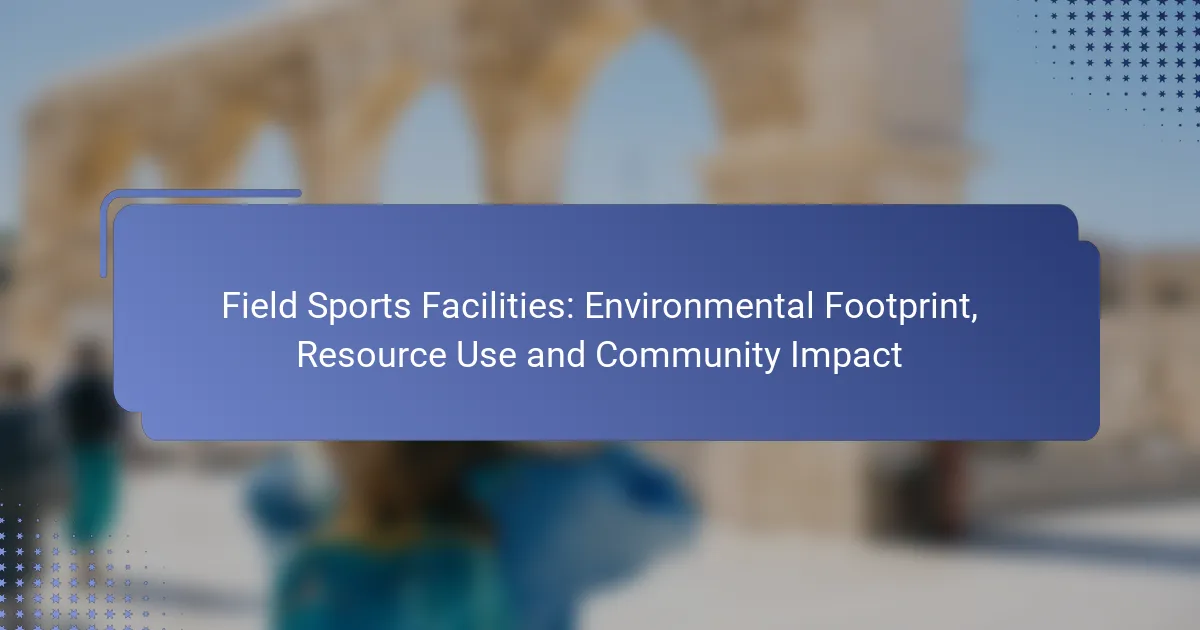Field sports programs play a vital role in promoting environmental education and awareness by actively engaging participants in local ecosystems. By combining physical activity with sustainability lessons, these programs not only foster appreciation for the environment but also provide significant community benefits, such as improved public health and social cohesion.

How do field sports programs promote environmental education in urban areas?
Field sports programs in urban areas enhance environmental education by engaging participants in activities that foster awareness and appreciation of local ecosystems. These programs often combine physical activity with lessons on sustainability, creating a practical learning environment.
Hands-on learning experiences
Hands-on learning experiences in field sports programs allow participants to directly interact with their environment. Activities like tree planting, habitat restoration, and wildlife monitoring provide tangible ways to understand ecological principles. For instance, a local soccer league might organize a day where players help clean up a nearby park, learning about the importance of maintaining green spaces.
These experiences often lead to deeper connections with nature, as participants see the immediate impact of their actions. Engaging in such activities can inspire a lifelong commitment to environmental stewardship.
Partnerships with local environmental organizations
Field sports programs frequently collaborate with local environmental organizations to enhance educational content. These partnerships can bring in expert knowledge and resources, such as workshops on biodiversity or conservation efforts. For example, a community basketball league might partner with a wildlife conservation group to host educational sessions on local species and their habitats.
Such collaborations not only enrich the educational experience but also strengthen community ties, as participants learn from local experts and contribute to regional conservation initiatives.
Integration of sustainability practices
Integrating sustainability practices into field sports programs is essential for promoting environmental education. This can include using eco-friendly equipment, implementing recycling initiatives, and encouraging carpooling to events. For instance, a local rugby club might adopt biodegradable materials for their events, setting a standard for environmental responsibility.
Additionally, educating participants about sustainable practices during training sessions can instill a sense of responsibility. Simple actions, like reducing plastic use or conserving water, can be emphasized to create a culture of sustainability within the sports community.

What community benefits arise from field sports programs?
Field sports programs provide numerous community benefits, including enhanced engagement, improved public health, and increased social cohesion. These programs foster connections among participants and promote a healthier lifestyle while strengthening community ties.
Enhanced community engagement
Field sports programs encourage active participation from community members, which helps build a sense of belonging. Local events, such as tournaments and training sessions, draw people together, fostering relationships and collaboration among diverse groups.
To maximize engagement, communities can organize regular events and outreach initiatives. Utilizing social media and local advertising can help reach a broader audience, ensuring that everyone feels welcome to join in.
Improved public health outcomes
Participation in field sports has been linked to better physical health, as it promotes regular exercise and active lifestyles. Engaging in sports can reduce the risk of chronic diseases, improve mental health, and enhance overall well-being.
Communities should consider offering programs that cater to various age groups and skill levels. By providing accessible options, such as free or low-cost activities, they can encourage more residents to participate and reap the health benefits.
Increased social cohesion
Field sports programs play a vital role in fostering social cohesion by bringing together individuals from different backgrounds. Shared experiences in sports can break down barriers and create lasting friendships, contributing to a more united community.
To strengthen social ties, communities can implement team-based activities that require collaboration and communication. Encouraging mixed-gender and multi-generational teams can further enhance inclusivity and promote a sense of unity among participants.

How can schools implement field sports programs effectively?
Schools can implement field sports programs effectively by integrating them into the existing curriculum, collaborating with local sports clubs, and ensuring proper funding and resource allocation. These strategies create a supportive environment that enhances student engagement and promotes environmental education.
Curriculum integration strategies
Integrating field sports programs into the curriculum involves aligning sports activities with educational goals. Schools can incorporate lessons on teamwork, leadership, and environmental stewardship through sports, making the learning experience more holistic.
Consider using project-based learning where students can participate in field sports while exploring topics like sustainability and health. This approach not only fosters physical fitness but also encourages critical thinking about environmental issues.
Collaboration with local sports clubs
Partnering with local sports clubs can enhance field sports programs by providing access to trained coaches and facilities. Schools should seek to establish relationships with nearby clubs to facilitate workshops, training sessions, and competitions.
These collaborations can also offer students opportunities to engage with their community, promoting a sense of belonging and responsibility. Schools might consider organizing joint events that highlight both sports and environmental awareness.
Funding and resource allocation
Securing funding for field sports programs is crucial for their sustainability. Schools can explore various funding sources, including grants, sponsorships from local businesses, and community fundraising initiatives.
Resource allocation should prioritize essential equipment and training materials. Schools should aim to create a budget that allows for regular maintenance of facilities and equipment, ensuring that students have safe and effective resources for their sports activities.

What are the best practices for promoting awareness through field sports?
Promoting awareness through field sports involves engaging the community and leveraging various platforms to highlight environmental education. Effective strategies include hosting events, utilizing social media, and collaborating with local influencers to spread the message.
Hosting community events
Community events serve as a powerful tool for raising awareness about environmental issues through field sports. Organizing activities such as clean-up drives, workshops, or sports tournaments can draw participants and encourage discussions on sustainability.
Consider partnering with local organizations or schools to maximize attendance and impact. Providing incentives, such as prizes or refreshments, can also enhance participation and foster a sense of community ownership.
Utilizing social media campaigns
Social media campaigns can effectively reach a broader audience and promote awareness of environmental initiatives linked to field sports. Creating engaging content, such as videos, infographics, or testimonials, can help convey messages in an appealing way.
Utilize popular platforms like Facebook, Instagram, and Twitter to share updates, event information, and educational materials. Consistent posting and interaction with followers can build a dedicated community around your cause.
Engaging local influencers
Collaborating with local influencers can amplify your message and increase visibility for environmental awareness in field sports. These individuals often have established trust and credibility within their communities, making them effective advocates.
Identify influencers who are passionate about environmental issues or field sports and propose partnerships for events or campaigns. Their endorsement can attract more participants and enhance the overall impact of your initiatives.

How do field sports programs compare to traditional education methods?
Field sports programs offer a hands-on approach to learning that contrasts with the more theoretical nature of traditional education methods. These programs engage participants in active experiences, fostering a deeper understanding of environmental issues and community dynamics.
Experiential learning advantages
Experiential learning in field sports programs allows participants to engage directly with their environment, enhancing their understanding through real-world applications. This method promotes critical thinking and problem-solving as individuals navigate challenges in outdoor settings.
For example, a program that involves tree planting not only teaches participants about ecology but also requires them to plan, execute, and reflect on their actions, reinforcing their learning through practice.
Increased retention of environmental concepts
Participants in field sports programs often show improved retention of environmental concepts compared to those in traditional classrooms. The active involvement and physical engagement help solidify knowledge, making it more memorable.
Research suggests that when learners are physically active, they are more likely to recall information later. For instance, a kayaking program that incorporates lessons on water conservation can lead to lasting awareness and advocacy for aquatic ecosystems.
Broader reach to diverse audiences
Field sports programs can attract a wider range of participants, including those who may not thrive in conventional educational settings. By integrating physical activity with environmental education, these programs appeal to various age groups and backgrounds.
Community-based initiatives, such as local sports leagues that emphasize sustainability, can engage families and individuals from different demographics, fostering a collective commitment to environmental stewardship.



